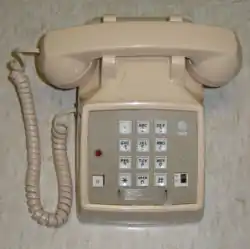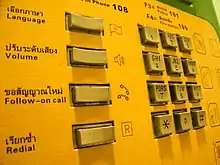Hook flash
Hook flash or flash (known in the UK as "recall") is a button on a telephone that simulates quickly hanging up then picking up again (a quick off-hook/on-hook/off-hook cycle). At the most basic level, using this would just drop the current call, and start a dial tone for the new call. However, on phone lines with special services, this action is used for signalling the telephone exchange to do something. A common use of a hook flash for special action is to switch to another incoming call with the call waiting service. Another use is to indicate a request for voice conferencing, for example, a user may use a procedure like the following to initiate three-way calling:
- Pick up phone handset (causing the line to be off-hook).
- Hear a dial tone
- Dial the first number and greet the first party
- Press the hook flash button (or quickly tap the on-hook sensor on the phone)
- Hear a stutter dial tone (a series of beeps followed by another dial tone)
- Dial the second number and greet the second party
- Press the hook flash button again.

The second "flash" signals the Central Office Switch to link the two active conversations, so that all three parties are connected to the same logical telephone line.
In contrast to PBX conferencing systems, the two calls are joined at the Central Office switch, rather than at the customer premises PBX.

Follow-on callbutton on a payphone, which is used for hook flashing; not to be confused with a
Redialbutton nearby.
On payphones, this function is usually provided with a button labeled "Follow-on call", which is mainly used for requesting another dial tone after finishing a call. This allows remaining credit to be used on another call[1][2][3] as payphones don't usually return changes.[4] With payphones that do not have this button, flashing the handset on and off-hook quickly will also perform the same action.
History
The switchhook is the device that senses whether the handset or receiver is in its cradle. The term "flash" originated from the cord circuit of the early telephone switchboard that telephone company operators used to connect calls. The calling party and called party each had an indicator light on the cord circuit. When the subscriber cycled the telephone on-hook/off-hook, the light would flash. Actors in old movies often demonstrate this method, seeking the operator's attention. The user does a tap-tap-tap. When an operator comes on the line, the actor says, "Hello? Operator? We've been cut off." Then the operator attempts to reestablish the connection. The flashing light of this equipment of bygone days is the origin of the phrase "flashing the switchhook".
Centrex telephones added a hook-flash button in the 1960s, after some users incorrectly attempted the attendant-recall function.
References
- Porter, Laura (2018-09-16). "Understanding Telephones in London". TripSavvy. Retrieved 2019-04-28.
- Freshwater, R. (2003-09-09). "BT Payphone 200 Mk 2". Bob's Telephone File. Retrieved 2019-04-28.
- "CT22A Blue Payphone AZ33". UK Payphones. Retrieved 2019-04-28.
- "Payphones". Australian Communications and Media Authority. 2018-06-12. Retrieved 2019-04-28.